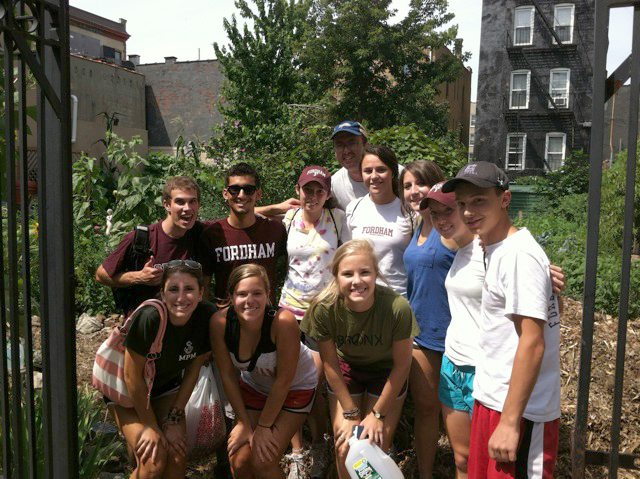
Fordham’s volunteer fair gives students a chance to make a difference with NYC community service organizations. Jeffrey Coltin for The Fordham Ram
By Jeffrey Coltin
The Bronx will enter Rose Hill’s gates Thursday afternoon with the annual volunteer fair. Nearly 50 community organizations will be looking for Fordham students to volunteer in the Bronx and across New York City. They’ll entice Fordham students with free pens, stickers and candy, in hope that it will be enough to get some Rams to hear about their organization.
The variety of service opportunities for students is almost as diverse as the Bronx itself. There’s JumpStart if you want to teach preschoolers, South Bronx United if you want to play soccer and tutor younger students and LIFT — The Bronx if you want to connect New Yorkers with housing and employment resources [V. 94, I. 21].
“There are a lot of service opportunities very close [to campus] in the Bronx,” Manny Caballero, PCS ’15, said. “You wouldn’t find the diversity of service opportunities [somewhere else], especially considering that so many opportunities are within a 10-15 minute walk.”
Caballero works at Fordham’s Dorothy Day Center for Service and Justice, which organizes the volunteer fair. Caballero said he “continually fell into service” after coming to Fordham and has worked most with College Access, a program that brings Bronx high school students to Rose Hill to guide them through the college application process.
Fordham’s location in the Bronx gives students countless opportunities for service and community organizing.
According to a 2013 NYU report, the combined Belmont/East Tremont neighborhood that lies just south of Rose Hill has the highest poverty rate (43 percent) and the highest unemployment rate (21 percent) in all of New York City. The borough as a whole has a very large immigrant population — according to the US Census Bureau, one in three Bronxites is foreign-born. Much of that population must deal with the legal, employment and assimilation issues that come with being an immigrant — all while dealing with a language barrier.
Still, the Bronx is more than just statistics. “We have a lot to learn from the Bronx,” Sandra Lobo-Jost, FCRH ’97, GSSS ’04, the director of the Dorothy Day Center, said. “Its history, its beauty in culture, music and art and its people who literally come from all over the world contribute to its diverse heritage.”
One student who is learning from the Bronx is Meredith Lukas, FCRH ’15. Lukas is a part of the Dorothy Day Center’s Community Organizing Group. This year they are partnering with other schools to help push immigration reform — and Fordham’s location is the perfect place for that.
“We have this great opportunity to work in a community where there are a lot of immigrants,” Lukas said. “And there are a couple service opportunities that we have to be able to humanize in order to get a face and a name to the issue.”
So would the Dorothy Day Center be the same if Fordham were in suburban Long Island instead of the Bronx? Lobo-Jost said the Dorothy Day Center could exist in any community.
“There is, however, no doubt,” she continued, “that our work is unique given that we are located in the Bronx and that we have created partnerships with organizations with which we have worked alongside to better our mutual community.”
Many of these partnerships go back a long way. Lobo-Jost said that in the peak days of the “Bronx is Burning” era in the mid-’70s, Fordham University collaborated with local clergy and residents to encourage investment back in the borough. She said it was out of this work that Fordham built relationships with community partners throughout the Bronx.
Lobo-Jost said that same idea of collaboration informs the Center’s relationships with community partners to this day. It focuses on creating “mutually beneficial relationships” as a way to serve “alongside residents of the Bronx” and not patronize those same residents.
There is still room to grow. Caballero said he feels “like Fordham hasn’t integrated itself in the Bronx, New York” — but he is still grateful to Fordham for giving him opportunities in social justice.
“I’m thankful to God I’m here,” he said, “because I see the world in a whole different way now.”
_______
Jeffrey Coltin is the Bronx Correspondent for The Fordham Ram.
